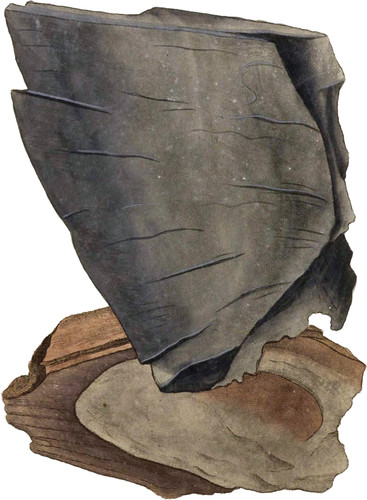 Enlarge
Enlarge
British Mineralogy
Vegetable Coal
- Class 1. Combustibles.
- Order 2. Compound.
- Gen. 5. Carbon.
- Spec. 2. Combined with bitumen and a small portion of vegetable matter.
- Div. 2. Amorphous.
- Syn. Bituminous Schistus. Hatchett in Linn. Trans. 4. 136.
Kimmeridge Coal, as spoken of by Mineralogists, is nevertheless not very generally known, nor would the substance, if found in any other place, from its aspect, be suspected as a Coal, and therefore has been casually overlooked by those who wanted specimens. It varies somewhat in appearance, as it sometimes divides with a very regular schistose fracture, and it is at other times more massive and earthy. The same is found a little above the level of the sea on the eastern side of Portland Island, as well as at Swanage in Dorsetshire, where it is met with at the same level. It is used at Swanage, and in some parts or Portland, for heating ovens; and although the Bitumen gives an uncomfortable odour if burned in a common fire, it does not, I am told, give any effluvia to affect the bread in the oven.
It may be known by its lightness, and taking an easy gloss with rubbing the nail over it; but more particularly by its strong blaze in a common fire. It is sometimes sold for a guinea per ton, and is often in large broad masses, three or four feet in diameter. It is also sometimes dug from the rock with a clay shovel.
The upper specimen is somewhat slaty in fracture, though rather more earthy. It is a softish clayey Shale with much Petroleum, and emits the smell peculiar to the latter substance when heated.
The lower specimen is still more earthy, but somewhat fissile, and is, as it were, interrupted with regard to its parallels by partly curving round an irregular ball of earthy Pyrites. It is a curious specimen;—sometimes Carbonate of Lime or Chalk intervenes, which is soft. Many other varieties occur, some of which are more slaty, some more earthy, and others of different colours.
The Isle of Wight, opposite Alum Bay, affords Bituminous Carbon in great variety. My kind friend Mr. Lyell favoured me with some that seems to point out the progress of the Bitumen passing from the vegetables and impregnating the substances near them. Lincolnshire affords a similar substance, with Lime of shells remaining betwixt the laminæ. I have some sent me by the Rev. R. B. Francis.
A mixture of Bitumen with Lime, Clav, &c, is sometimes found in Essex, nearly resembling this. I have been favoured with it by Colonel Walford.

